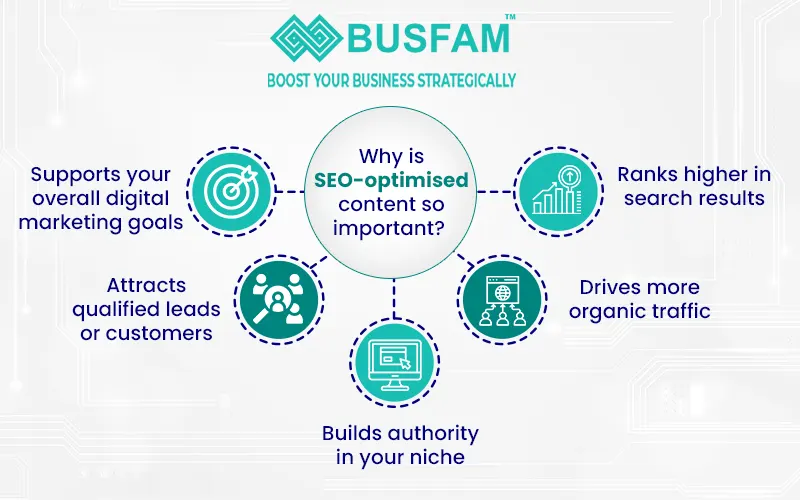

Are you struggling to get your blog posts noticed in the crowded digital space, even after trying so hard? You are not alone. This is the reality of thousands of brands that put so much effort into creating high-quality content only to notice little or no visibility.
It has to be remembered that simply writing content won’t do anything. It needs to be optimised with the right SEO strategies to rank it in search engine pages and capture the attention of the audience.
Search engine optimised content means making deliberate changes to your blog post so that Google and search engine pages can understand it better and present it to users who are searching for related topics.
SEO-optimised content refers to any kind of content, such as blogs, landing pages, website content, social media posts, or product descriptions, that is created to rank well on search engine pages like Google and Bing.
The higher a content ranks on the SERP, the more organic traffic it receives, which ultimately leads to more brand visibility, engagement and potential conversions.
So, if you want your content to be discoverable and relevant for your audience, optimisation is not an option; rather, it is a must for the long-term success of your brand, says an expert from a digital marketing agency in Kolkata.

Here is the step-by-step guide to optimise your content.
Keyword research: SEO starts with keywords; it is the foundation of a successful SEO strategy. Before you start writing your content, identify the words and phrases that your audience is looking for. You can use tools like Ubersuggest and Semrush to find relevant keywords with search volume and low competition.
Look for a combination of short-tail and long-tail keywords to maximise your reach and improve the chance of ranking for both competitive and niche search terms.
Craft a compelling title: Your blog title is the first thing that users notice about your content. Hence, a digital marketing agency in Kolkata always advises making it catchy and relevant to the content to attract more clicks. Don’t forget to include the primary keyword naturally to help search engines understand what your post is about and align it with what users are searching for.
A well-optimised title not only increases your chances of ranking the content higher in search results but also grabs the attention of users to read your content over others.
Use header tags: Header tags, such as H1 and H2, are essential for breaking down the content into readable sections, which makes it easy for readers to understand the structure of the post. Insert keywords at least in H2 to help Google index your blog post and display certain features as snippets.
The H1 should be used for the main blog title, while H2 is required for primary section headings. To further organise your content, you can use H3, H4, or H5 as sub-sections under H2 for a detailed explanation.
Use keywords throughout the content: Using keywords is the fundamental part of SEO optimisation. Identify the primary keywords and insert them throughout the blog post for search engines to identify the topic and relevance of your post. For effective results, integrate keywords in the first 100 words of your content. Also, use it in H1 and at least in one H2 tag for better visibility.
According to the opinion of a digital marketing agency in Kolkata, one of the common mistakes that writers make is overstuffing the content with keywords. Always aim for a balanced and natural use for better readability and ranking.
Write an engaging meta title and description: The meta title is the bold, clickable headline that appears in the search results, while the meta description is the summary that appears below it. Make sure to write the meta title between 50 and 60 characters, along with keywords, to attract clicks. The meta description should also be between 150 and 160 characters with a primary keyword and a call to action.
Together, both the meta title and description can make or break whether a user decides to click. Hence, don’t forget to keep them relevant and accurate.
Add internal and external links: including internal and external links is useful for improving both SEO and user experience. Internal links help the readers navigate to the related pages on your website, thereby helping search engines crawl your site.
External links, on the other hand, redirect the readers to reputable third-party sources, which in turn boosts credibility and authority. Always link to trusted websites to strengthen your content and improve search engine rankings.
Follow the above tips to fully optimise your blog posts and rank them on the first page of your search engine results. If you are still finding it difficult, partner with a digital marketing agency in Kolkata, like BUSFAM. The expert will help with keyword research and content strategy to make your brand visible.